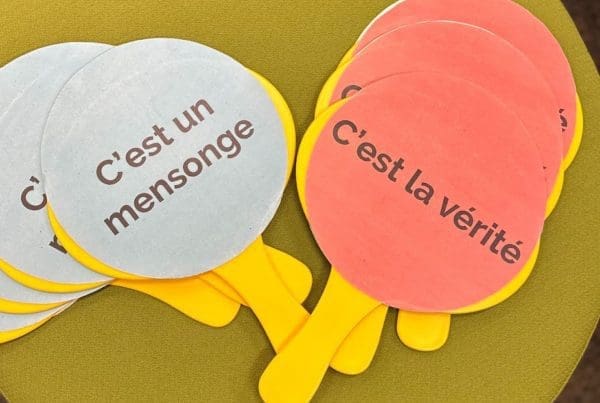While browsing through Instagram recently, I stumbled upon an intriguing activity known as “Boom, Clap, Snatch.” Though I regret not being able to credit the ingenious mind behind this concept, I was captivated by its simplicity.
The video showcased two rows of students standing and facing each other, with a paper plate resting on the floor between them. When the instructor uttered “Boom,” the students responded with synchronized foot stomps. The command “Clap” led to a harmonious chorus of handclaps. And finally, the prompt “Snatch” set off a frenzy as students vied to be the first to seize the plate using only their feet. For a visual representation, you can watch the video below.
Inspired by this activity, I’ve rebranded it as “Toc, Tête, Saisis.” The name draws from the French word “toc,” which translates to “knock,” and resonates with a resource from the Nous Sommes materials I incorporate into my French I & II classes. If you are unfamiliar with Martina Bex’s materials, I wholeheartedly recommend exploring them. The Nous Sommes curriculum has been a welcome addition to my teaching. The curriculum has seamlessly integrated seamlessly, saving me valuable time and effort! You can explore these resources here.
Here’s how I orchestrated the Toc, Tête, Saisis activity with my high school students: Organized into pairs or trios, my students sat on the floor with a Jenga block placed between them.
The object’s nature is open-ended—it can range from dice and marbles to fuzzy balls. I opted for a Jenga block, simply because it was the first item I stumbled upon in my storage cabinet!
I provided clear instructions, ensuring everyone understood the rules. In cases where clarity was lacking, I displayed the key phrases in both French and English on the board:
- “Quand je dis toc, tu frappes le sol avec deux mains.” (When I say knock, you hit the ground with two hands.)
- “Quand je dis tête, tu touches la tête avec deux mains.” (When I say head, you touch your head with two hands.)
- “Quand je dis saisis, tu vas essayer de saisir le bloc de Jenga plus vite que ton partenaire.” (When I say grab, you are going to try to grab the Jenga block faster than your partner.)
Then, the gameplay unfolded as follows:
- “Toc, toc, toc, tête, tête, toc, tête, toc, toc, toc, saisis.” (Knock, knock, knock, head, head, head, knock, head, knock, knock, knock, grab.)
- “Si tu as gagné, lève la main.” (If you’ve won, raise your hand.)
- As the students played, I circulated around the room, engaging with my students.
- “Emma, tu as un point? Tu as saisi le bloc plus vite que Mial! Bravo!” (Emma, do you have a point? You grabbed the block faster than Mia! Well done!)
The cycle continued:
- “Tête, tête, tête, tête, toc, toc, toc, toc, tête, tête, toc, toc, toc, saisis.”
- “Si tu as gagné, lève la main.” (If you’ve won, raise your hand.)
- “Montre-moi combien de points tu as.” (Show me how many points you have.)
In total, we played three or four rounds, enough to crown a champion or two in the room. To maintain unpredictability, I varied the frequency of saying “toc,” “tête,” or “saisis.”
This activity unveiled an interesting observation: students had to listen, comprehend, and respond for successful gameplay. I’ve found this activity effective either as a class opener to synchronize everyone or as a brain break midway through class. Furthermore, the added exposure to high-frequency words such as “try,” “grab,” “show me,” etc., is an added benefit.
For those curious about the game in action, I’ve captured my students’ involvement in a brief video below. Toward the video’s conclusion, you’ll see a variation of the game involving body parts—a testament to the numerous possibilities this activity offers.



